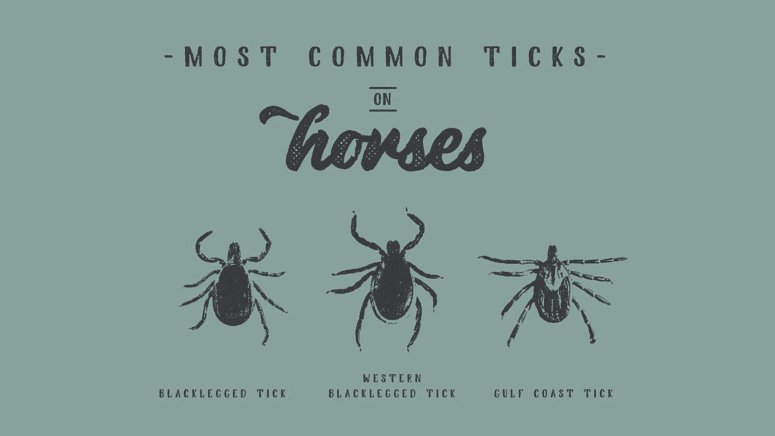
Posted by Gabby Gufler, Mon, Apr 29, 2019
We all hate ticks, and this year there are more than ever! Tick bites are worrisome because they can not only cause skin reactions and/or infections, but also spread disease. We put together an infographic outlining the top three most common horse ticks in the U.S., the diseases they carry and where they are located.
The most common tick-borne diseases of which horse owners should be aware are Lyme disease and anaplasmosis, which are covered in depth below.
What is Lyme disease?
Lyme disease in horses is caused by the bacterium Borrelia burgdorferi. Horses are exposed to this organism through tick bites, but luckily few develop clinical illness post–tick bite. Clinical signs of Lyme disease include lameness, joint swelling, muscle stiffness and behavioral changes. Lyme disease can be challenging to diagnose, as it mimics many other diseases. It is important to contact your veterinarian right away if you think your horse may be exhibiting signs of Lyme disease.
Did you know?
According to the USDA Animal and Plant Health Inspection Service, in some regions 50% of horses can show antibodies to the Lyme disease pathogen but only 10% show clinical symptoms. More than 70% of the ticks reported to feed on horses also feed on humans, transmitting the same pathogens which cause tick-borne diseases to you!
What is anaplasmosis?
Anaplasmosis is the most common tick-transmitted disease that causes illness in horses. The causative organism is called Anaplasma phagocytophilum. Clinical signs of anaplasmosis usually appear 10–45 days after infection. Clinical signs include a fever typically accompanied by limb swelling and the appearance of small hemorrhages on the mucous membranes of the nose, mouth, eyes and/or vulva. This disease can be fatal if not treated, so be sure to contact your veterinarian if you think your horse is showing signs of anaplasmosis.
How can we minimize tick exposure?
- Maintain Pastures. If you have a pasture, keep it at a length that allows for adequate pasture grazing and yet reduces tick-seeking sites. Remove as much leaf litter and weeds as possible. Prevent horses from grazing in wooded areas by installing a fence.
- Discourage Wildlife. During the summer, try discouraging wildlife by feeding your horse grain in containers, and keep all stored grain in tightly sealed containers.
- Inspect Your Horse. Inspect your horse daily and remove attached ticks while grooming. Be sure to check susceptible areas such as the lower legs, under the mane and tail, the belly, and around the throat latch and ears.
- Apply a Tick Repellent. Spray your horse thoroughly with a tick repellent that is specifically labeled for use against ticks, such as Pro-Force® Fly Spray.
- Consider Chickens or Guinea Hens. These birds are known for feasting on pesky ticks, plus you can get fresh eggs! Discuss your plan of action with your veterinarian before introducing these birds to your pastures.
Avoid products that are not intended for use on horses. If you’re not sure, check with your veterinarian.
If a horse is severely infested with ticks, it is recommended that you immediately contact your veterinarian regarding tick removal. Heavy infestations will not only severely damage the skin, but the chances of anemia and other complications are high.
How Do You Properly Remove a Tick?
The safest and most effective way to remove ticks on horses is to use the tweezer method! Place your tweezers as close to your horse’s skin as possible, grasp the tick firmly and pull. Be sure to remove the entire tick. Heads/mouth parts are rarely left behind; should this happen, however, use the tweezers to pull out the remaining parts.
Tick bites are worrisome because they spread disease and the bites can cause skin reactions, sometimes with infection. Usually, by the time the bite is discovered, horses have large, weeping, crusty areas in the mane that eventually cause hair loss as well.
Cold, snowy weather is actually the perfect winter environment for ticks! Lasting snow cover provides insulation for ticks throughout the winter. So if you have a harsh winter, be prepared for an increase in the number of ticks the following spring. Protect your horse from ticks this summer with Nature’s Force® Fly Control. If you are worried about chemicals, Nature’s Force also repels ticks. It is an all-natural formula that uses a unique combination of oils and other botanicals rather than harsh chemicals or pesticides.
- Repels biting insects including mosquitoes, yellow flies, black flies, no-see-’ems, gnats, chiggers, ticks and deer flies
- Environmentally friendly; contains no insecticides, pesticides or toxins
- Stronger formula than other leading natural fly repellents
Author Profile: Gabby Bick
Gabby Bick graduated from Truman State University in 2013 with a BS in Animal Science & Nutrition and a minor in Equine Science. Gabby currently works on Manna Pro’s marketing team, and enjoys competing regularly with her six horses.
More Blogs by Gabby Bick
- https://www.mannapro.com/equine/itching-for-spring-learn-to-identify-treat-horse-skin-conditions
- https://www.mannapro.com/equine/best-tactics-for-tackling-mold-on-leather-tack
- https://www.mannapro.com/equine/good-bye-sun-bleaching-6-summer-horse-grooming-tips
- https://www.mannapro.com/equine/horse-skin-conditions-battling-tail-rubbing
- https://www.mannapro.com/equine/solutions-for-healthy-horse-weight-gain
- https://www.mannapro.com/equine/10-things-you-can-do-with-your-horse-besides-horse-riding
- https://www.mannapro.com/equine/no-hoof-no-horse-8-spring-horse-hoof-care-tips
- https://www.mannapro.com/equine/10-stress-free-horse-transportation-tips
- https://www.mannapro.com/equine/spring-horse-training-tips-conditioning-senior-horses
- https://www.mannapro.com/equine/15-must-know-horse-grooming-tips-secrets
- https://www.mannapro.com/equine/keep-your-tack-room-organized-horse-leather-care-tips
- https://www.mannapro.com/equine/top-5-most-deadly-horse-diseases
- https://www.mannapro.com/equine/beat-the-heat-importance-of-horse-liniments-post-workout-leg-care
- https://www.mannapro.com/equine/see-real-results-with-calf-manna-for-horses-grune-hiedi
Featured Products

